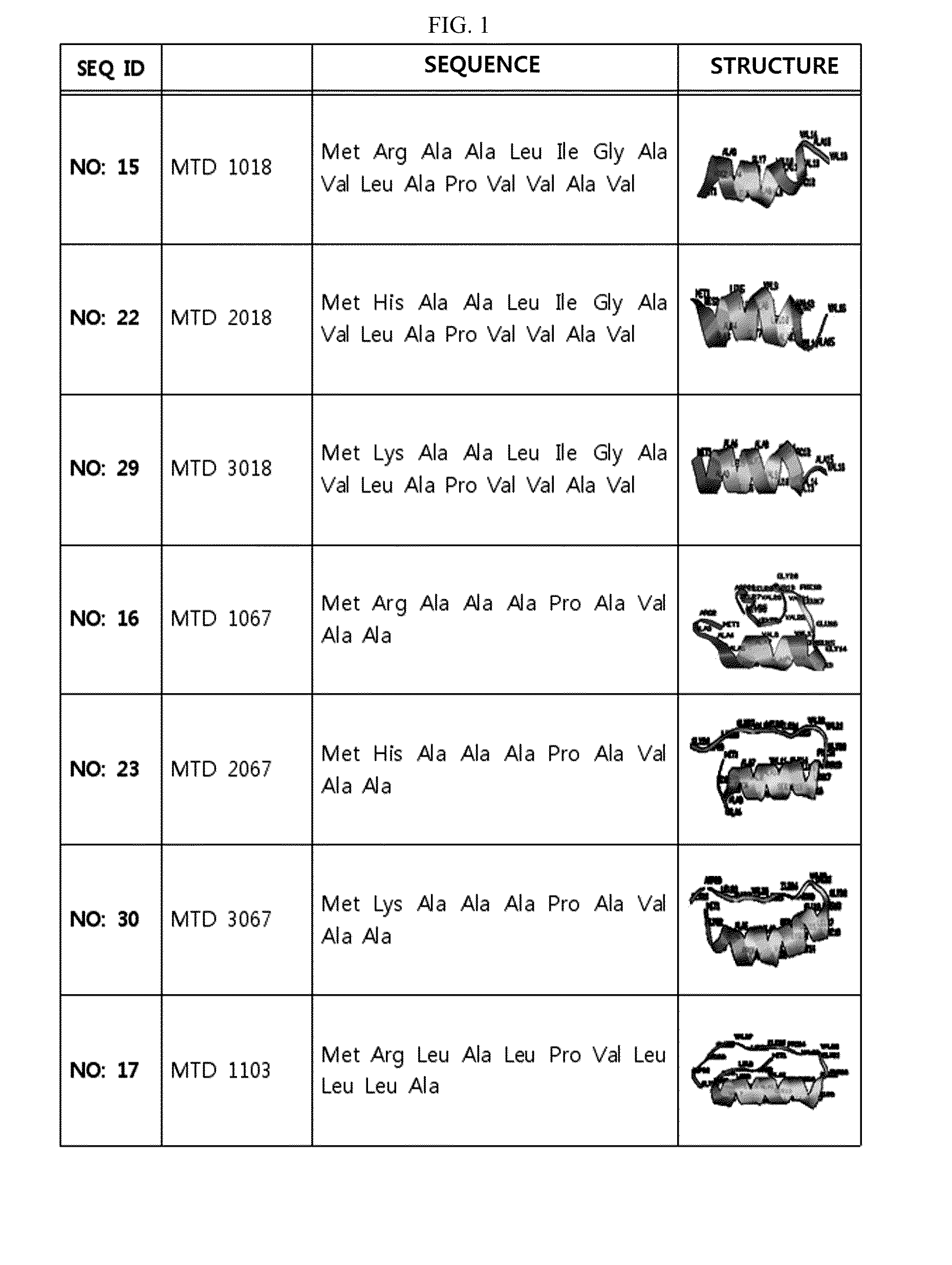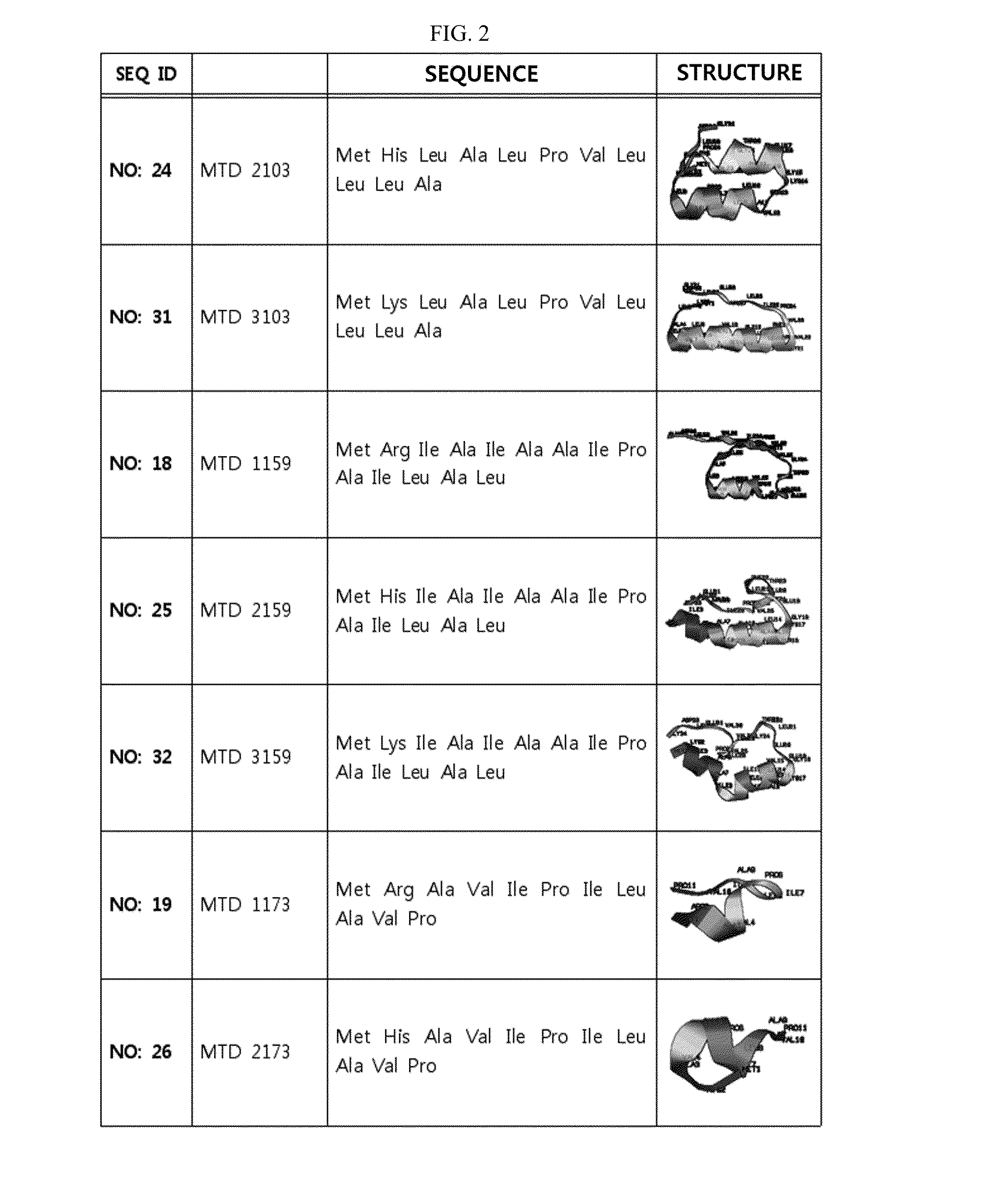Development of Novel Macromolecule Transduction Domain with Improved Cell Permeability and Method for Using Same
a macromolecule and cell permeability technology, applied in the direction of peptides, pharmaceutical active ingredients, peptides, etc., can solve the problems of reducing the efficiency of delivery, ptd has difficulty in transducing materials such as peptides, proteins, nucleic acids, etc., and achieves excellent cell permeability of delivering, and effectively maintains the activity of the delivered biologically active molecule in the cell
- Summary
- Abstract
- Description
- Claims
- Application Information
AI Technical Summary
Benefits of technology
Problems solved by technology
Method used
Image
Examples
example 1
Selection of MTD Peptide to Invent Modified MTD
[0119]The inventors selected a sequence of a target MTD to enhance transducibility in a sequence satisfying the following conditions of sequences quantified for relative comparison among 193 MTDs developed in Korean Patent Publication No. 110-2009-0103957 which is the technology previously developed by the inventors.
[0120]Conditions for the selection are as follows:
[0121]1) Among sequences of macromolecule transduction domain, a sequence of MTD in which proline was located in the middle was selected.
[0122]2) Among sequences of macromolecule transduction domain, a sequence of MTD having a high extracellular secretion-inducibility was selected.
[0123]3) Among sequences of macromolecule transduction domain, a sequence of MTD satisfying a specific level of an aliphatic index, which is a factor determining physiochemical characteristics of the MTD, was selected.
[0124]4) Among sequences of macromolecule transduction domain, a sequence of MTD s...
example 2
Invention of Modified MTD
[0148]For the 7 target MTDs selected in Example 1, 1 to 2 hydrophilic (polar) amino acids were added to be applied to a hydrophobic domain, thereby increasing approachability to a cell membrane, and thus producing a new modified MTD more efficiently delivering a biologically active molecule into a cell, and therefore a peptide represented by the following Formula was invented:
A1-A2-MTD; [Formula 1]
[0149]Here, A1 is methionine (M, Met); A2 is an amino acid selected from the group consisting of arginine (R, Arg), histidine (H, H is) and lysine (K, Lys), which are positively-charged; and MTD is a 7-amino-acid sequence selected from the group consisting of SEQ. ID. NOs: 1 to 7 selected in Example 1.
[0150]The sequence of the modified MTD invented through Formula 1 is the same as one of the amino acid sequences described in SEQ. ID. NOs: 15 to 35, and a peptide is synthesized based on the invented amino acid sequence, thereby confirming cell permeability.
example 3
Analysis of Secondary Structure of Modified MTD
[0151]A secondary structure of the modified MTD invented in Example 2 was analyzed using a PEP FOLD server program.
[0152]As a result, as shown in FIGS. 1 to 4, it was confirmed that the modified MTD invented in Example 2 did not damage a structural characteristic of the MTD disclosed in Korean Patent Publication No. 10-2009-0103957, entitled “NOVEL MACROMOLECULE TRANSDUCTION DOMAINS AND METHODS FOR IDENTIFICATION AND USES THEREOF,” and maintained an α-helix structure increasing permeability of the cell membrane.
PUM
| Property | Measurement | Unit |
|---|---|---|
| Permeability | aaaaa | aaaaa |
| Toxicity | aaaaa | aaaaa |
Abstract
Description
Claims
Application Information
 Login to View More
Login to View More - R&D
- Intellectual Property
- Life Sciences
- Materials
- Tech Scout
- Unparalleled Data Quality
- Higher Quality Content
- 60% Fewer Hallucinations
Browse by: Latest US Patents, China's latest patents, Technical Efficacy Thesaurus, Application Domain, Technology Topic, Popular Technical Reports.
© 2025 PatSnap. All rights reserved.Legal|Privacy policy|Modern Slavery Act Transparency Statement|Sitemap|About US| Contact US: help@patsnap.com



